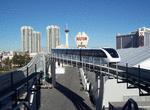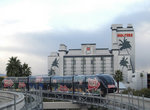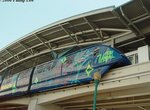Las Vegas, Nevada
![]()
Las Vegas monorail at the Las Vegas Hilton. Photo by David Pirmann, July 2006.
Las Vegas Monorail
The expanded Las Vegas monorail system opened (with a few false starts) July 15, 2004, between Sahara and MGM Grand. It's fast, clean, comfortable, convenient assuming you want to go where it goes, contemporary, and just a little bit sterile. Compared to other recent transit systems' station design there is not much architectural flair in the design of the stations. There are seven stations in operation. The fare is $3 per ride, high in price compared to transit systems in other cities, but time-based passes are available to lower the per-ride cost.
There are nine trains of four cars each, each car is totally enclosed and isolated from one another. Each car has one set of sliding doors on either side. The system is fully automated and the trains do not require an operator, but the front and rear cars of each train have a full width cab for an attendant or operator if necessary. Some of the trains are "wrapped" in advertisements, but several remain "plain label" white at this time. The trains were built by Bombardier Transit Corporation of Canada, and are very similar to those at the Walt Disney World and Disneyland theme parks. In addition, Bombardier was contracted to operate and maintain the monorail system for the first five years.
Despite being new, the trains provide a rougher ride than expected, especially on the south end, the original MGM-Bally route. It's obvious where the old and new sections connect, a distinct upslope just north of the Bally's station, and south of Flamingo. The ride is smoother from that point on. The starts and stops are very smooth, no lurches, no screeching halts.
For those familiar with how subway and el stations are described, all of these stations are 2-track, center platform, except for the Sahara station. Sahara has an unused second platform to the west of the main one as a provision for future extension downtown. All stations have sliding doors at the platform sides, opening only when a train is in the station. When the monorail enters a station, chimes sound, and a voice announces the direction (i.e. "Northbound Monorail is entering the station"). The monorail doors align with the platform doors, and both sets open and close at the same time. The platforms can get quite "stuffy", being surrounded with only openings at the north and south ends of the station.
In late January, 2005, a news item appeared indicating that Federal funding for the monorail extensions to downtown had been scrapped. One extension would have branched off the main line around the Hilton station running to a single station at Las Vegas Boulevard South near the Riviera and Stardust hotels. The downtown extension would continue north from Sahara and provide stations at Oakey Blvd., Charleston Blvd., Bonneville Avenue, and Stewart Avenue (Fremont). Another train storage facility would also be built near Bonneville Avenue station.
Station By Station
We begin the journey at Sahara, for a home-run to the MGM Grand to get a feel for the line and to keep an eye out for what's interesting. The Sahara station has a large parking garage and surface lot. Access to the monorail station at the Sahara is via a passage between a convenience store and the entrance to the Alexandria Tower. An escalator takes you up over the station to an open-air mezzanine above the platforms. An elevator and another set of escalators leads downward to the parking lot below. Escalators and stairs lead down to the station platform. Sahara is typical in design and architecture to the other five of the new stations, having a bluish metal arched cylindrical roof and wide-spaced I-beams.
Compared to el stations in other cities such as Chicago, with diverse designs ranging from Queen Anne to Art Moderne to contemporary, these Las Vegas stations are quite plain by comparison, but still pleasing to the eye.
Departing Sahara, the train doors close and the ride begins. The train pulls straight southbound along the east side of Paradise until it crosses Karen Avenue and then curves to the east onto the Las Vegas Hilton property.
Las Vegas Hilton has the mezzanine below the platform, the only station on the newer north side of the system to have this. An escalator leads down to ground level, and a covered walkway leads to the Hilton entrance, by the Star Trek attraction. (Rumor has it there is a "Star Trek"-wrapped train but it wasn't seen.)
The next leg of the journey to the Convention Center station takes us high up, southwest and then south past the original part of the Las Vegas Convention Center. The Las Vegas Convention Center station is actually at the intersection of Paradise Road and Desert Inn Road, above Desert Inn on the east side of Paradise. It appears that if an event is going on in the "N" halls of the Convention Center, it will be closer to exit at the Hilton station than the Convention Center station, but still quite a hike. The Convention Center station is typical of construction, with the topside mezzanine, but is the station with the most obvious corporate sponsorship, that being Nextel, with a Nextel sales office very conveniently located topside and adjacent to the exit. In addition, a bright yellow train is adorned with Nextel logo ad-wrap.
This next leg is the longest between any two stations on the route, but the speed achieved is nothing spectacular. The route heads south from the Convention Center station, turns southwest across what appears to be the corner of the Hughes Center property or an old golf course, for the most bucolic scenery, if there is such a thing, on the trip. There are several curves, and each has an accompanying slowdown, so a long run at higher speed is not possible. The route swings west in the median of Sands Avenue and then turns sharply left to the south in the median of Koval Lane and hugs the Sands Expo Center to the east and south. We then run west of and parallel to Audrie Street as the Colonel slows down for the Harrahs/Imperial Palace station.
The Harrah's/Imperial Palace station is the first of two very similar mirror-image stations that are probably the closest two stations on the route. They both have the mezzanine above the platform, with an escalator to ground level. A long covered walkway and escalator leads to both casinos, with signs giving equal exposure to both hotels. The trip to Flamingo/Caesar's Palace is very brief, and, as mentioned, the station is a carbon copy of that at Harrah's/Imperial Palace.
Departing southbound from Flamingo/Caesars, the tracks curve first to the left (east) over Flamingo Road, past the foot of Audrie Street, and then sharply to the south just east of the Bally's sports book. The tracks pass through an extremely narrow gap between the buildings and then descend on a marked downgrade toward the Bally's station, which is the connection to the original monorail system between Bally's and MGM.
The two southernmost stations are older, part of the original MGM-Ballys route, and somewhat different in architecture than those on the newer northern part of the system. At Bally's/Paris, the beamwork is thinner and more evident, more "busy", spare in color, some with blue and silver-gray outer covering. The roof is cylindrical, but oriented lengthwise across curved upper beams.
Departing Bally's, the train takes on an almost capacity crowd to the end of the line, the MGM Grand station. This part of the route seemed much faster in speed, faster with a lot more rumble and vibration. Although the MGM station is the end of the line, the tracks continue south and curve to the east, allowing a train to relay from one track to the other to pick up northbound passengers. Although the train from Bally's was full, there was almost nobody waiting for a northbound train. The detraining crowd left the station quickly, leaving it almost vacant.
The ride from MGM to Sahara was almost exactly 17 minutes, very close to the claimed 15.
Route Map

Inter-Hotel Shuttle Trams
In addition to the Monorail, several hotels also run private (but free) shuttle trams between adjoining properties, typically within the same hotel ownership/management group. There are three of these trams, all on the west side of the Strip (the Las Vegas Monorail is on the east side). Only one can truly be called a monorail by itself, the other two use two tracks to support and guide the vehicles. Also, none of these three tram lines use electric traction motors, instead opting for cable haulage (or, in one case, what appears to be a rubber "band"). The cars of course have electricity for lights and air conditioning.
Mandalay Bay-Luxor-Excalibur
Starting at the south end, the tram connecting Mandalay Bay, Luxor, and Excalibur is the most extensive of these systems. Cable hauled, there are two tracks with one train on each. There are four stations. The "east" track has a station at Excalibur "North", or "Express", at the corner of Las Vegas Blvd. and Tropicana Avenue, and one at Mandalay Bay. This monorail runs express from Excalibur direct to Mandalay Bay. Presumably this is done to whisk customers quickly to Mandalay Bay as it is at the far south end of the Strip and customers might be discouraged from walking all the way down. Boarding this express monorail is not permitted in the northbound direction at Mandalay Bay station. The "west" track monorail shuttles between Mandalay Bay, Luxor, and a station directly adjacent to the Excalibur Hotel. The shuttle monorail does not enter the Excalibur "express" station although the track runs all the way and presumably, it could serve that station as well. Unfortunately this arrangement means that a passenger starting at Excalibur "Express" station cannot return there, instead having to get off at Excalibur Hotel and navigate through its casino to return. Each station is enclosed, fully accessible, and air-conditioned with platform doors protecting access to the trackway, except the Luxor station which is outdoors. The vehicles resemble those of the Las Vegas Monorail or those at Disney properties; the two tracks run fairly close to Las Vegas Boulevard and cross several streets including Mandalay Bay Road and Reno Drive; as such, this one is the most visible of the three hotel tram systems.
Monte Carlo-Bellagio
The next system northward connects the Monte Carlo Hotel with the now-famous Bellagio. This monorail runs between the rears of the hotels across some parking lots, but the stations are well-appointed, enclosed, fully accessible, and air conditioned. The two trains (one permanently mounted on each track) are rather bulbous monstrosities and are hauled with what appears to be a rubber belt running alongside the running rail. The cars appear to run in a "counter balanced" system departing their terminal stations at the same time and meeting in the middle, but hopefully can be operated independently such that one car can be out of service for maintenance without affecting operations.
The Monte Carlo-Bellagio tram closed for the construction of City Center.
Mirage-Treasure Island
Finally, there is a tropical safari-themed cable-hauled tram running between Mirage and Treasure Island. The Mirage station is an outdoor, covered platform directly to the right of the main entrance to the hotel; at Treasure Island the station is in the rear on the second level. This tram consists of one car shuttling back and forth on a single track.
Photo Gallery
| Five Random Images | ||||
 Image 17714 (165k, 1044x788) Photo by: David Pirmann Location: Mandalay Bay Station |  Image 17717 (348k, 1044x788) Photo by: David Pirmann Location: Luxor Station |  Image 36543 (224k, 864x648) Photo by: D. Reinecke Location: Las Vegas Convention Center |  Image 58414 (144k, 864x561) Photo by: Peter Ehrlich Location: MGM Grand |  Image 76872 (115k, 800x600) Photo by: Phillip Lee Location: Las Vegas Hilton |
Photos By Location
Photo locations: Las Vegas Monorail-Location Unknown, Stewart/Fremont, Bonneville, Charleston, Oakey, Sahara Maint. Shops, Sahara, Las Vegas Hilton, Las Vegas Convention Center, Between Convention Center & Harrah's, Harrah's/Imperial Palace, Between Harrah's & Flamingo, Flamingo/Caesar's Palace, Bally's/Paris Las Vegas, MGM Grand, Monorail interior view.
Page Credits
By D. Reinecke and David Pirmann. Route Map by David Pirmann.